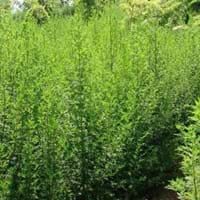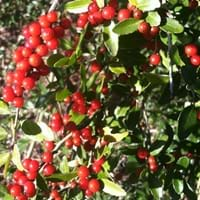Life Span
Annual
Perennial
Type
Shrub
Broadleaf Evergreen
Origin
Hybrid origin
Southeastern United States
Types
Not available
Not Available
Habitat
Subtropical forests, Tropical Forests
sand dunes, Sandhills, Well Drained, Wet lands
USDA Hardiness Zone
Not Available
7-11
AHS Heat Zone
12-8
Not Available
Sunset Zone
Not Available
21,22
Habit
Upright/Erect
Upright/Erect
Flower Color
Not Available
White
Flower Color Modifier
Not Available
Bicolor
Fruit Color
Not Available
Red
Leaf Color in Spring
Not Available
Green, Dark Green
Leaf Color in Summer
Not Available
Green, Dark Green
Leaf Color in Fall
Not Available
Dark Green
Leaf Color in Winter
Not Available
Dark Green
Leaf Shape
bipinnate
Elliptic and Ovate
Plant Season
Spring, Summer, Fall
Spring, Summer, Fall, Winter
Sunlight
Full Sun, Partial Sun
Full Sun, Partial Sun, Partial shade, Full Shade
Growth Rate
Medium
Medium
Type of Soil
Loam, Sand
Clay, Loam, Sand
The pH of Soil
Acidic, Neutral
Acidic, Neutral, Alkaline
Soil Drainage
Well drained
Average
Bloom Time
Not Available
Spring
Tolerances
Drought, Salt
Drought
Where to Plant?
Ground, Pot
Container, Ground, Pot
How to Plant?
Seedlings
Cuttings
Plant Maintenance
Medium
Medium
Watering Requirements
Average Water Needs
Average Water Needs, Drought Tolerant
In Summer
Lots of watering
Lots of watering
In Spring
Moderate
Moderate
In Winter
Average Water
Average Water
Soil pH
Acidic, Neutral
Acidic, Neutral, Alkaline
Soil Type
Loam, Sand
Clay, Loam, Sand
Soil Drainage Capacity
Well drained
Average
Sun Exposure
Full Sun, Partial Sun
Full Sun, Partial Sun, Partial shade, Full Shade
Pruning
Remove damaged leaves, Remove dead branches, Remove dead leaves
Remove damaged leaves, Remove dead branches, Remove dead leaves
Fertilizers
All-Purpose Liquid Fertilizer, Apply N-P-K
All-Purpose Liquid Fertilizer
Pests and Diseases
Aphids, Gray leaf blight, Root rot
Red blotch
Plant Tolerance
Drought, Salt
Drought
Flowers
Insignificant
Insignificant
Flower Petal Number
Not Available
Single
Fragrant Bark/Stem
Yes
No
Foliage Texture
Not Available
Fine
Foliage Sheen
Not Available
Glossy
Attracts
Insects, Not Available
Bees, Birds
Allergy
Pollen
Eye irritation, Itchiness, Nausea, Rash
Aesthetic Uses
Not Used For Aesthetic Purpose
Not Used For Aesthetic Purpose
Beauty Benefits
Skin inflammation
Not Available
Environmental Uses
Air purification
Air purification
Medicinal Uses
Antioxidants, Fever, Inflammation, Malaria
Digestion problems, Fever, Heart problems, hypertension, Making Herbs, Rheumatism
Part of Plant Used
Leaves
Leaves
Other Uses
Medicinal oil, Oil is used for aromatherapy
Used as Ornamental plant
Used As Indoor Plant
No
No
Used As Outdoor Plant
Yes
Yes
Garden Design
Foundation, Mixed Border, Rock Garden, Wall
Container, Feature Plant, Foundation, Hedges, Mixed Border, Topiary, Bonsai, Espalier
Botanical Name
Artemisia annua
ILEX vomitoria 'Nana'
Common Name
sweet wormwood, sweet annie, sweet sagewort, annual mugwort
Dwarf Yaupon Holly
In Hindi
Artemisia
Dwarf Yaupon Holly
In German
Artemisia
Dwarf Yaupon Holly
In French
Artemisia
Dwarf Yaupon Holly
In Spanish
Artemisia
Dwarf Yaupon Holly
In Greek
Αρτεμίσια
Dwarf Yaupon Holly
In Portuguese
Artemisia
Dwarf Yaupon Holly
In Polish
Artemisia
Dwarf Yaupon Holly
In Latin
Artemisia
Dwarf Yaupon Holly
Phylum
Magnoliophyta
Magnoliophyta
Class
Magnoliopsida
Magnoliopsida
Order
Asterales
Celastrales
Family
Asteraceae
Aquifoliaceae
Clade
Angiosperms, Asterids, Eudicots
Angiosperms, Asterids, Eudicots
Tribe
Anthemideae
Not Available
Subfamily
Asteroideae
Not Available
Number of Species
Not Available
Properties of Artemisia and Dwarf Yaupon Holly
Wondering what are the properties of Artemisia and Dwarf Yaupon Holly? We provide you with everything About Artemisia and Dwarf Yaupon Holly. Artemisia doesn't have thorns and Dwarf Yaupon Holly doesn't have thorns. Also Artemisia does not have fragrant flowers. Artemisia has allergic reactions like Pollen and Dwarf Yaupon Holly has allergic reactions like Pollen. Compare all the properties and characteristics of these two plants. Find out which of these plant can be used as indoor plant. If you are interested to decorate your house and garden, find out aesthetic uses, compare them and select the plant which will beautify your surrounding. Along with beautification, try comparing medicinal and edible uses of Artemisia and Dwarf Yaupon Holly and you can choose the plant having best and most benefits.
Season and Care of Artemisia and Dwarf Yaupon Holly
Season and care of Artemisia and Dwarf Yaupon Holly is important to know. While considering everything about Artemisia and Dwarf Yaupon Holly Care, growing season is an essential factor. Artemisia season is Spring, Summer and Fall and Dwarf Yaupon Holly season is Spring, Summer and Fall. The type of soil for Artemisia is Loam, Sand and for Dwarf Yaupon Holly is Clay, Loam, Sand while the PH of soil for Artemisia is Acidic, Neutral and for Dwarf Yaupon Holly is Acidic, Neutral, Alkaline.
Artemisia and Dwarf Yaupon Holly Physical Information
Artemisia and Dwarf Yaupon Holly physical information is very important for comparison. Artemisia height is 150.00 cm and width 150.00 cm whereas Dwarf Yaupon Holly height is 90.00 cm and width 120.00 cm. The color specification of Artemisia and Dwarf Yaupon Holly are as follows:
Artemisia flower color: Not Available
Artemisia leaf color: Not Available
Dwarf Yaupon Holly flower color: White
- Dwarf Yaupon Holly leaf color: Green and Dark Green
Care of Artemisia and Dwarf Yaupon Holly
Care of Artemisia and Dwarf Yaupon Holly include pruning, fertilizers, watering etc. Artemisia pruning is done Remove damaged leaves, Remove dead branches and Remove dead leaves and Dwarf Yaupon Holly pruning is done Remove damaged leaves, Remove dead branches and Remove dead leaves. In summer Artemisia needs Lots of watering and in winter, it needs Average Water. Whereas, in summer Dwarf Yaupon Holly needs Lots of watering and in winter, it needs Average Water.





